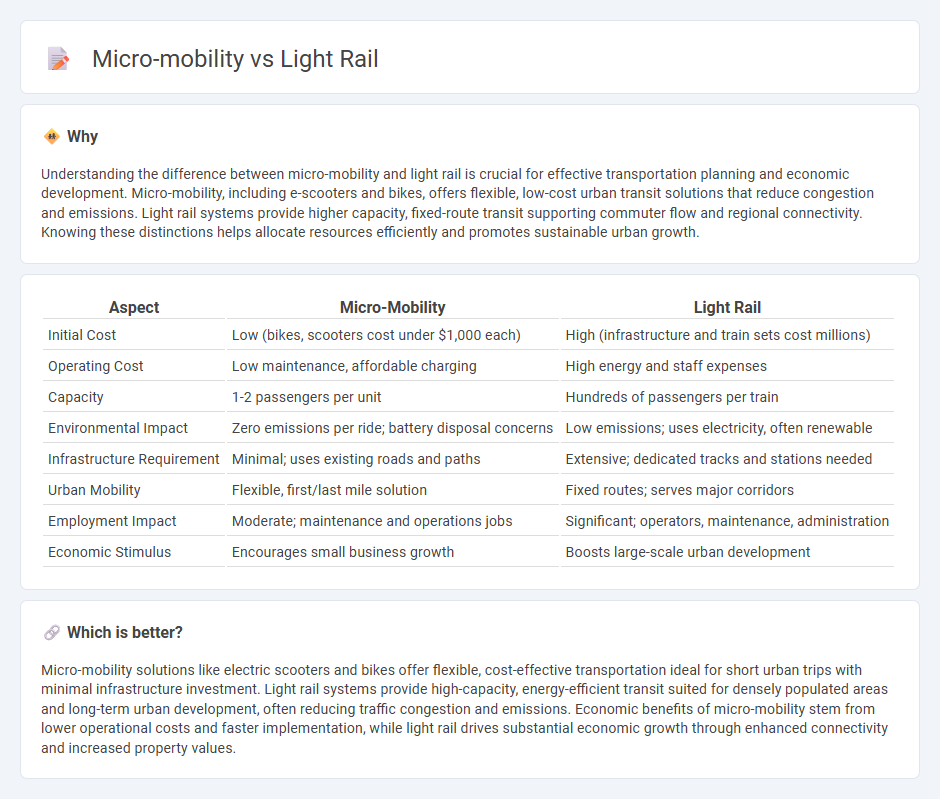
Micro-mobility solutions like e-scooters and bike-sharing offer cost-effective, flexible urban transportation with lower infrastructure investments compared to light rail systems. Light rail provides high-capacity transit and reliable service but requires significant capital expenditure and longer implementation timelines. Explore the economic trade-offs between micro-mobility and light rail to understand their impacts on urban transit development.
Why it is important
Understanding the difference between micro-mobility and light rail is crucial for effective transportation planning and economic development. Micro-mobility, including e-scooters and bikes, offers flexible, low-cost urban transit solutions that reduce congestion and emissions. Light rail systems provide higher capacity, fixed-route transit supporting commuter flow and regional connectivity. Knowing these distinctions helps allocate resources efficiently and promotes sustainable urban growth.
Comparison Table
| Aspect | Micro-Mobility | Light Rail |
|---|---|---|
| Initial Cost | Low (bikes, scooters cost under $1,000 each) | High (infrastructure and train sets cost millions) |
| Operating Cost | Low maintenance, affordable charging | High energy and staff expenses |
| Capacity | 1-2 passengers per unit | Hundreds of passengers per train |
| Environmental Impact | Zero emissions per ride; battery disposal concerns | Low emissions; uses electricity, often renewable |
| Infrastructure Requirement | Minimal; uses existing roads and paths | Extensive; dedicated tracks and stations needed |
| Urban Mobility | Flexible, first/last mile solution | Fixed routes; serves major corridors |
| Employment Impact | Moderate; maintenance and operations jobs | Significant; operators, maintenance, administration |
| Economic Stimulus | Encourages small business growth | Boosts large-scale urban development |
Which is better?
Micro-mobility solutions like electric scooters and bikes offer flexible, cost-effective transportation ideal for short urban trips with minimal infrastructure investment. Light rail systems provide high-capacity, energy-efficient transit suited for densely populated areas and long-term urban development, often reducing traffic congestion and emissions. Economic benefits of micro-mobility stem from lower operational costs and faster implementation, while light rail drives substantial economic growth through enhanced connectivity and increased property values.
Connection
Micro-mobility solutions such as e-scooters and bicycles complement light rail systems by providing efficient first- and last-mile connectivity, easing urban congestion and enhancing accessibility. Integrating these modes reduces reliance on cars, lowers carbon emissions, and boosts public transit ridership. Urban planners leverage this synergy to create sustainable, multimodal transportation networks that support economic growth and reduce infrastructure costs.
Key Terms
Capital Expenditure (CapEx)
Light rail systems require substantial Capital Expenditure (CapEx) for infrastructure development, including tracks, stations, and power systems, often running into hundreds of millions or billions of dollars. Micro-mobility solutions like e-scooters and bikes involve significantly lower CapEx, focusing primarily on vehicle procurement and minimal docking infrastructure. Explore detailed cost comparisons and financial models to optimize urban transportation investments.
Last-Mile Connectivity
Light rail offers high-capacity, fixed-route transit solutions ideal for connecting urban centers, while micro-mobility options like e-scooters and bikes provide flexible, short-distance travel bridging gaps between transit hubs and final destinations. Micro-mobility addresses last-mile connectivity by enhancing accessibility, reducing travel time, and lowering emissions in dense, congested areas. Explore the evolving role of these transportation modes in optimizing urban mobility and sustainability.
Operational Efficiency
Light rail systems offer high passenger capacity and consistent service schedules, enabling efficient mass transit in urban areas. Micro-mobility solutions such as e-scooters and bike-sharing provide flexible, last-mile connectivity with lower operational costs and reduced infrastructure demands. Explore how integrating these modes enhances overall urban transportation efficiency.
Source and External Links
Light rail - Wikipedia - Light rail (or light rail transit, LRT) is a form of urban passenger rail transit using tram-derived vehicles, operating mainly on exclusive rights-of-way with lower capacity and speed than heavy rail or rapid transit, but sometimes overlapping with tram or light metro systems.
Light Rail - Austin Transit Partnership - Light rail in Austin is an electric-powered train system running on dedicated railway tracks with frequent service, offering faster, reliable transit that integrates with multiple transportation modes while supporting environmental and economic benefits.
Light Rail - Routes - Hampton Roads Transit - Hampton Roads Transit provides light rail service with scheduled frequent intervals throughout the day, focusing on reliable, efficient urban transit with defined weekday and weekend operating hours.
 dowidth.com
dowidth.com